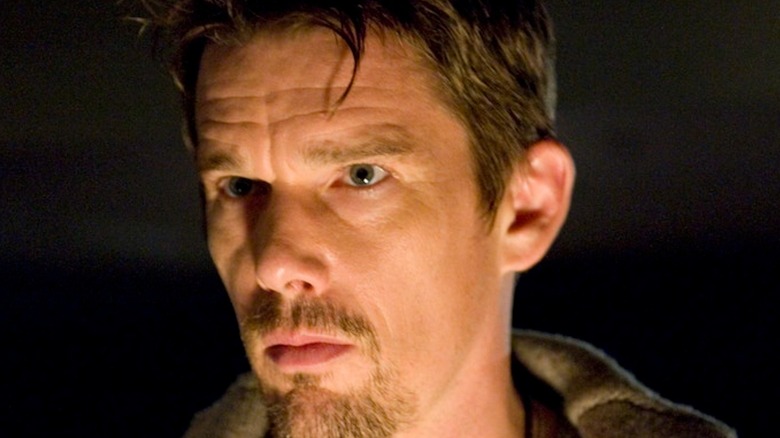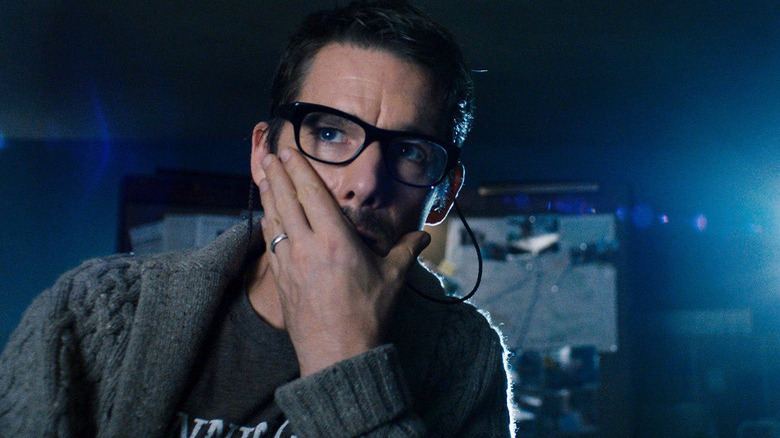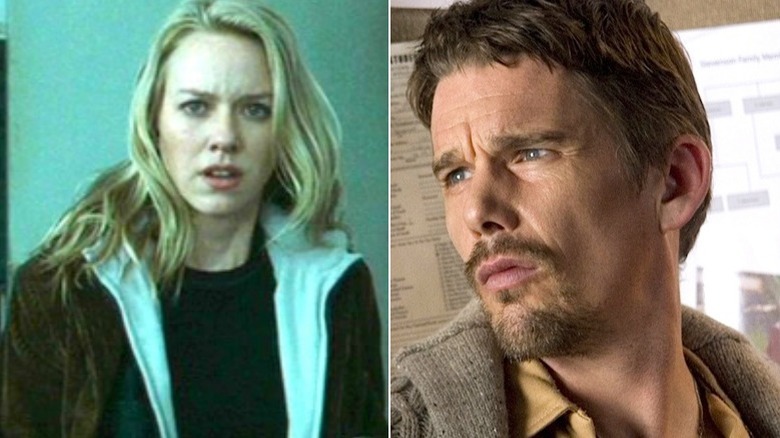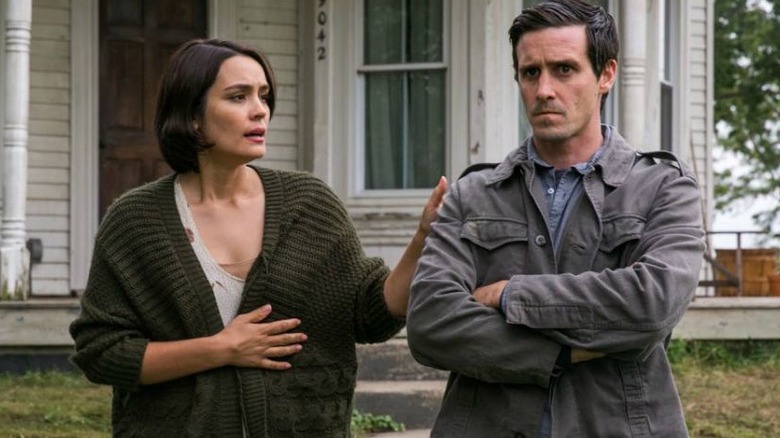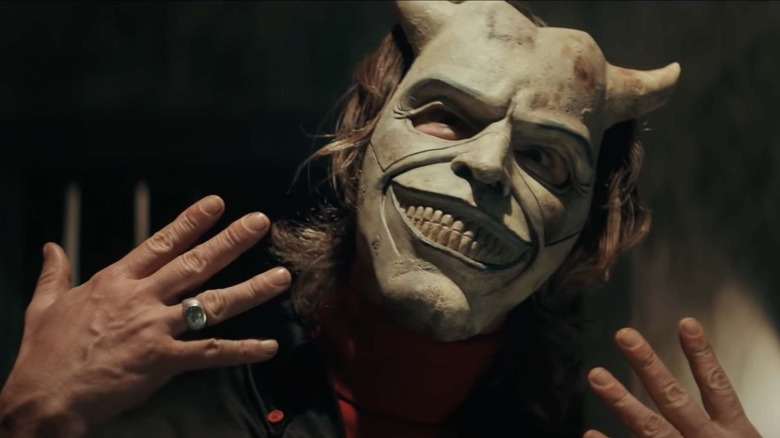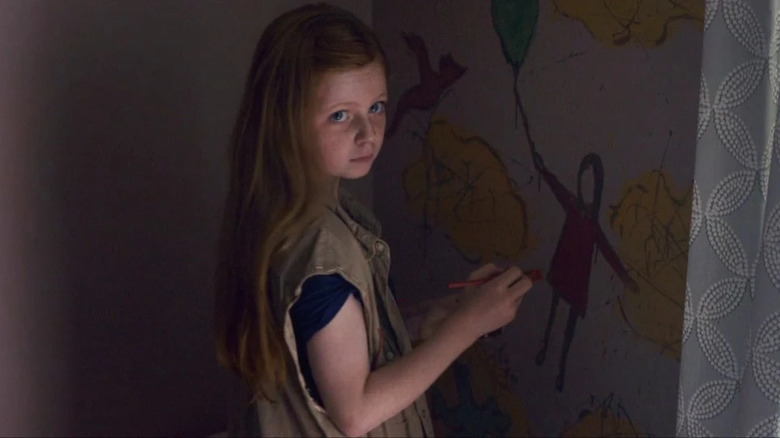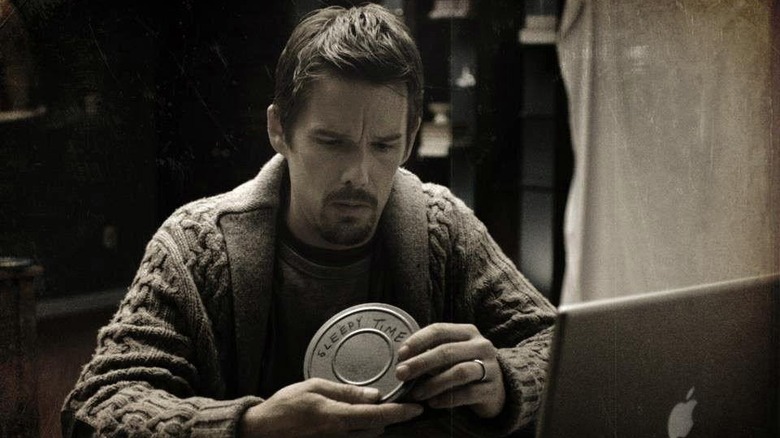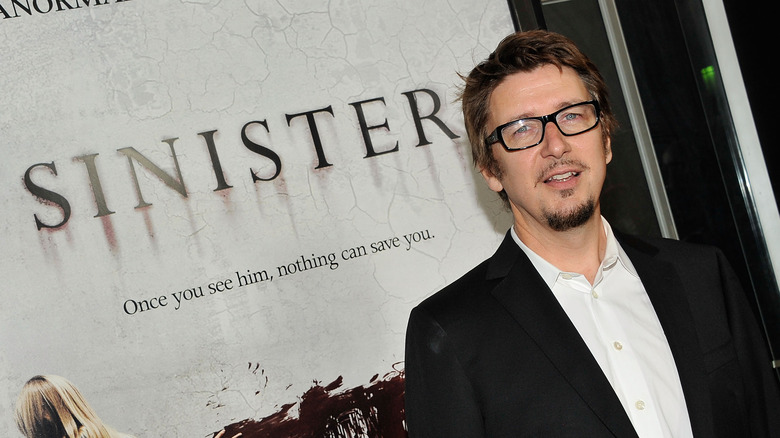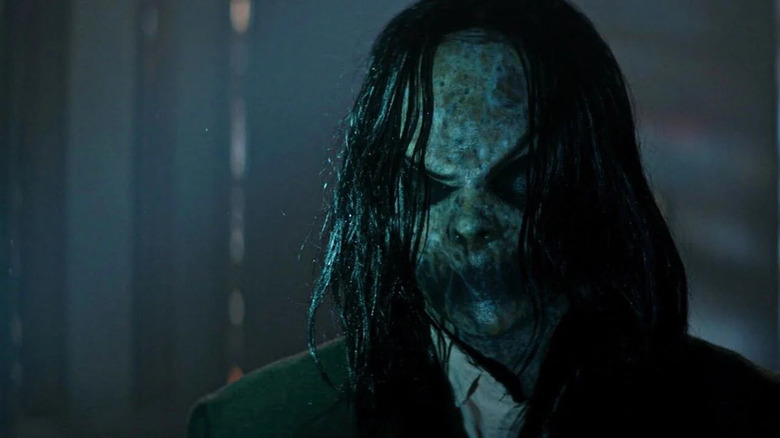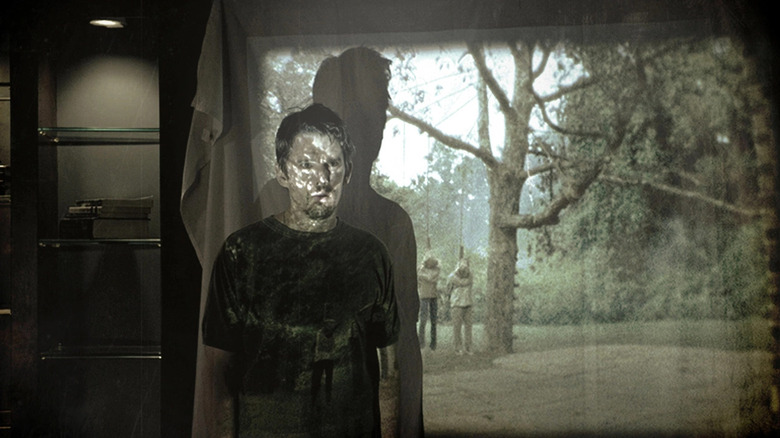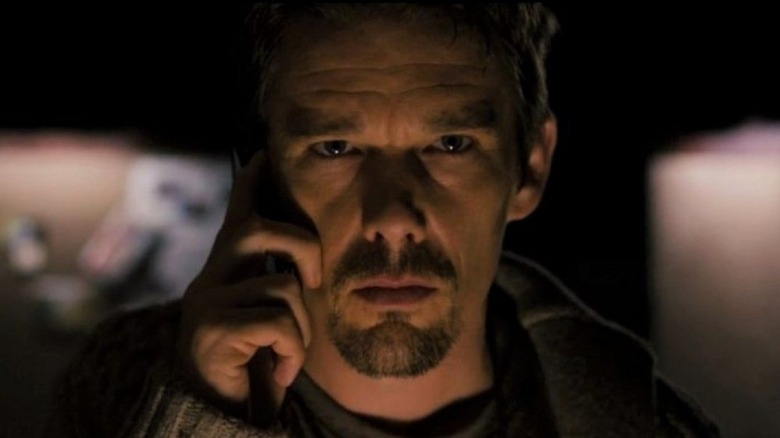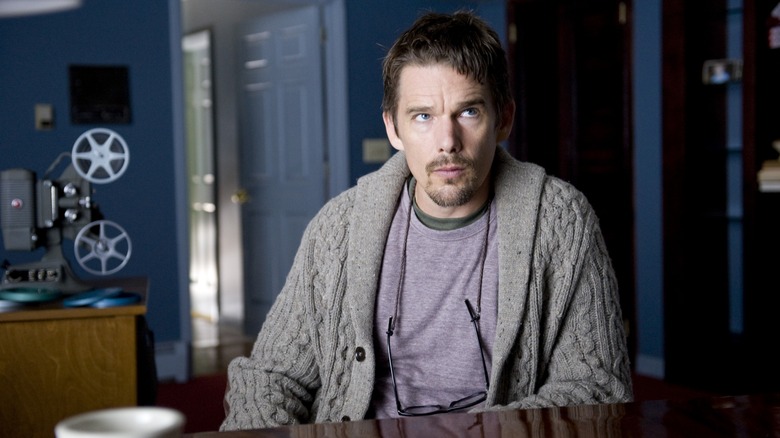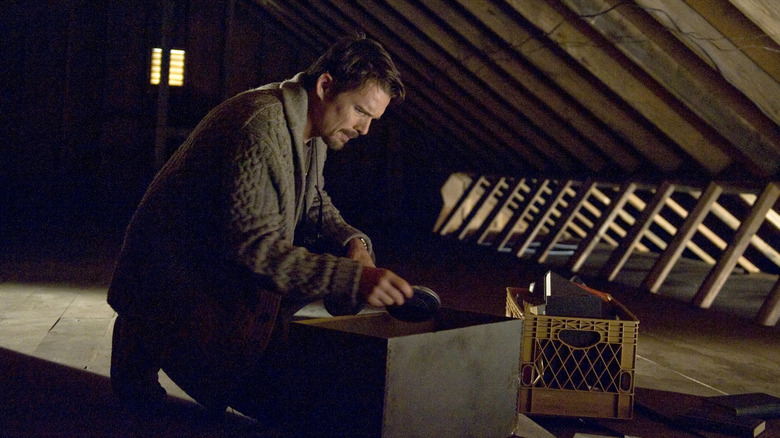Sinister: The Story Behind The Scariest Movie Ever Made
In 2012, director Scott Derrickson and screenwriter C. Robert Cargill came together and made "Sinister," a landmark horror film that would go on to define a decade brimming with some of the smartest, most terrifying titles ever. With Ethan Hawke playing protagonist Ellison Oswalt, "Sinister" redefined the Texan actor's career that would lead to a run of "Before Midnight," "The Purge," and "Boyhood" within a year's time.
But "Sinister" hasn't just endured because of Hawke's incredible performance; it's been touted as one of the scariest movies ever made while becoming a cult classic among horror buffs. With a unique use of found footage and the examination of how careerism informs the human condition, "Sinister" is an apt commentary on the innate urge to pry into the mysterious horrors that catch our collective interest. 10 years later, few films have managed to conjure as much terror as "Sinister." Many have tried, but Derrickson and Cargill's story remains singular... even if it originated from a nightmare about another famous horror movie. Here is the story behind the twisted and unforgettable "Sinister," from the film's low budget to Derrickson's floundering career to the renaissance of Super 8 cameras.
Low-budget, high-gross
Before achieving mass acclaim with films like "Get Out," "Us," "Halloween," and "Happy Death Day," Blumhouse Productions spent years building a horror movie empire. Starting in 2009, Blumhouse cashed in on their low-budget, high-gross mode with films like "Paranormal Activity" and "Insidious."
Those two titles were made for $230,000 and $1.5-million and each made over $100-million. When 2012 came around, the company funded "Sinister" for $3-million and made their money back 20 times over. With a total gross of $87.7-million at the box office worldwide, "Sinister" became one of the movies that turned Blumhouse into what it is today. The production company is still making movies with below $20-million budgets but, without "Sinister," there'd be no "Purge" franchise or hits like "The Invisible Man" and "The Black Phone." Though it didn't have the box office firepower of studio films like "The Avengers," "Skyfall," "The Lorax," or "The Hunger Games," "Sinister" was a great success and finished the year as the fifth-highest grossing horror movie of 2012 domestically, behind "The Woman in Black," "Paranormal Activity 4," "The Devil Inside," and "The Possession."
Connections to The Ring
Cargill was inspired to write "Sinister" after having a bone-chilling nightmare spurred by his recent viewing of Gore Verbinski's "The Ring." In Cargill's nightmare, he finds himself in an attic full of Super-8 films. One of the reels featured an entire family being hung from a tree, which would eventually inspire some of the most famous imagery from "Sinister."
"Sinister" and "The Ring" share a number of similarities, namely that both films' protagonists are struggling writers and discover sentient video footage. Though "The Ring" focused on children, "Sinister" portrays how the horrors of the unknown can affect an adult. As Ellison is hungry for another best-selling book, he spares no expense in solving the mystery of the Stevenson family murders. In turn, he moves his own family into the Stevenson house and puts them all, unknowingly, into grave danger.
Like Samara in "The Ring," the demon in "Sinister" takes the shape of a young girl to try and murder the other characters. The Kellers and the Oswalts share incredibly different fates, though, as Rachel (Naomi Watts) and her children survive, while Ellison and his wife and children do not. Beyond the comparisons, however, "Sinister" is good enough, and original enough, to stand apart from "The Ring."
Sinister was a critical success, but Sinister 2 was widely panned
"Sinister" didn't get rave reviews that put the film on many year-end lists in 2012, but its 63% Rotten Tomatoes score shouldn't be overlooked. Out of the five-highest grossing horror movies of 2012, "Sinister" clocked in with a silver medal — second only to "The Woman in Black," which holds a 66% critics score. But in 2015, Derrickson and Cargill returned to write "Sinister 2," which floundered at the box office and in the hearts of critics, grossing $54-million worldwide and registering an awful 14% critics score.
Once "Sinister 2" hit theaters, audiences quickly grew to miss what made "Sinister" so fascinating. The sequel was an earnest attempt at continuing the universe first assembled by Derrickson and Cargill, but, without Derrickson in the director's chair, the movie suffered from a lack of originality. It was a messy retread of what "Sinister" achieved with nowhere near enough heart to make it memorable. The found footage parts still ended up being cool, just like in the original installment, but terrible performances by James Ransone and Shannyn Sossamon unspool any momentum this film could've had. Further solidifying that not every solid horror movie needs a sequel, the disastrous "Sinister 2" should have been a cautionary tale about unnecessary continuations. Instead, sequels are being churned out at a rapid pace and there's no end in sight. Luckily, there are no plans for a "Sinister 3," and audiences are better off for it.
Scott Derrickson and Ethan Hawke reunited after Sinister
Because his character Ellison dies at the end of the first film, Hawke did not reprise his role in "Sinister 2." However, his creative partnership with Derrickson didn't stop there. A decade after "Sinister," Derrickson would write and direct "The Black Phone" with Hawke playing the Grabber, a magician moonlighting as a serial killer and abductor.
It's no coincidence that two amazing Hawke performances have been in his partnership with Derrickson. The two men clearly have a great chemistry together, as Derrickson is able to tap perfectly into Hawke's versatile acting range. So few contemporary stars can effectively play a victim and a menace, but Hawke's dynamic on-screen breadth is visceral and wildly underrated. For a long time, there was a discussion to be had about whether or not "Sinister" was Hawke's apex when it comes to scary movies, but in "The Black Phone," the actor makes a good case that he still has a lot to give to the horror genre.
Sinister 2 uses a different point of view
In "Sinister 2," the narrative perspective shifts away from the adults and onto the children. Dylan Collins (Robert Daniel Sloan) is a young boy constantly tormented by whatever spirit haunts the house he now lives in. Those spirits make him watch home movies of people being murdered, harkening back to the events of the first film.
Unlike "Sinister," which focused on an average American family with a patriarch who means well, "Sinister 2" uses an abusive father plot that is meant to emphasize Dylan's susceptibility to being taken advantage of by the supernatural. It's an interesting commentary on how trauma makes people vulnerable, but Cargill and Derrickson's story leaves a lot to be desired, as "Sinister 2" is nothing beyond a paranormal horror flick. It was easy to make Ellison a writer who ended up doing too much in order to tell the perfect story, but making Dylan an innocent kid who is the child of abuse but not examining it with the right amount of empathy feels washed out and exploitative.
The use of Super 8 cameras
A big part of what makes "Sinister" so great is the use of home videos. Though the footage can sometimes feel expository, it's hard to introduce that type of plot point in a way that is totally organic. It makes sense that Ellison is searching for clues as to why the Stevenson family was murdered, and, in the process, stumbles upon video tapes that depict their killings.
All of the home video footage and snuff films were shot with authentic Super 8 cameras. Speaking with Cinema Blend, Derrickson recalled wanting to achieve a type of film grain that was nostalgic for him. "It's very grainy. And when you blow it up, especially on the big screen, the grain is very particular. The color, the way it captures color is different," the director said. "The way it has always felt to me, and this includes Super 8 films that [I] would find that my grandfather shot that I would watch on the home projector when I was a kid. They always feel a little creepy to me." The way "Sinister" is shot overall is unique. The monochrome moments are emphasized by brilliant lighting, and the authentic grain from the Super 8 footage emphasizes that the world Ellison and his family are trapped in is a familiar, terrifying one.
Sinister was a make-or-break film for Derrickson
Derrickson is not a landmark horror director in the same way like a John Carpenter or Wes Craven. However, he's made a few decent films over the course of his two decades spent behind the camera. His feature-length directorial debut came in 2000 when he helmed the fifth "Hellraiser" movie, "Hellraiser: Inferno." As was the case with many of the "Hellraiser" sequels, it was a critical flop thanks to the cast and crew being unable to capitalize on the film's low budget and direct-to-video production — plus, its 14% Rotten Tomatoes score didn't signal a promising career for Derrickson, and he wouldn't direct another movie for five years.
"The Exorcism of Emily Rose," Derrickson's next film, found modest success — mostly at the box-office. Critics disliked the movie, though audiences actually did like it. It was Derrickson's 2008 movie, "The Day the Earth Stood Still," an adaptation of the 1951 original, that put his career on the ropes. The sci-fi thriller made a lot of money but fared poorly with both critics and audiences and left him without a directorial credit for four years. Luckily, "Sinister" changed Derrickson's trajectory, amassing enough critical and commercial acclaim to net him three more directing gigs, including "Doctor Strange" in 2016.
The Bughuul demon's origins
The demon that haunts the protagonists of both "Sinister" and "Sinister 2" is not a real deity, thankfully. Bughuul, known as Mr. Boogie, the Boogeyman, and the "devourer of children," is one of the most menacing antagonists in recent horror history.
Even if Bughuul isn't from a deep cavern in mythological history, he is said to be the brother of Moloch, a Canaanite god that appears often in the book of Leviticus chapter of the Hebrew Bible. Moloch takes the shape as an idol with a bull head and is connected to the act of child sacrifice. Much like his brother, Bughuul is also a practitioner of child sacrifice, as is evidenced in the familial killings within the "Sinister" franchise. The medieval study of pagan gods is used cleverly in "Sinister." Rather than creating a villain whose evil stems from some unknowable place, Derrickson and Cargill crafted an antagonist rife with historical and Biblical elements that can be traced back thousands of years. There's something more terrifying about a monster based on myths of the Punic language that has been studied for centuries than a knife-wielding superhuman who is immune to death.
Practical effects vs. CGI
Hollywood is overloaded with films using CGI, to the point where even the outlandish, otherworldly details look too unbelievable. In "Sinister," however, Derrickson and Cargill used nearly 1,600 visual effects shots because they didn't have the budget for anything else. Even at surface level, the eerie tints of certain scenes were all done practically... because the filmmakers couldn't afford to make green screen burn-ins in post-production.
In an interview with The Film Stage, Derrickson cited Christopher Nolan as inspiration. "If you can shoot it real it will look better," the director said. "And that's why [Christopher] Nolan's movies look better than anybody else's big budget movies. Because he has that mantra in his mind. He doesn't like CGI. He wants to shoot it real." As a result, the effects used in "Sinister" make the entire movie all that more terrifying. Though it's not as gory as some of the non-digital work done in 1980s slashers and body horror work, the practicality of "Sinister" adds to the way it affects its audiences. Beyond the nostalgia of Super 8 film, the camera work lets us step into Ellison's world as he tries to solve the mystery of the Stevenson murders.
BlackBerry vs. iPhone
At the end of the film's credits, "Sinister" filmmakers offer their thanks to a long list of people and businesses who helped guide the movie across the finish line. Among them, near the beginning, is BlackBerry, a now-defunct smartphone brand that, at one point, made the most innovative cell phones money could buy.
Movies thanking companies in the end credits is not unusual, and "Sinister" spared no expense when it came down to delivering shout-outs. Brands like Heineken, Nike, Oriental Trading Co., and Microsoft get their day in the sun by the horror movie's end. What's funny about BlackBerry's inclusion, though, is that the characters in "Sinister" exclusively use iPhones.
Ellison, in particular, makes a few phone calls on his iPhone, which you can plainly see. In an interview with the Film Stage, Derrickson and Cargill both claimed to have no idea why BlackBerry was thanked in the credits, given that the phone company has no product placement across the 109-minute run time. "We had all the Apple stuff, but how the Apple stuff worked was they really have their brand under control," Cargill noted. "If you come to them and say, 'We want to make a movie,' they'll say, 'Hey, let us give you this stuff, You can use it and use all the logos.' They don't pay. But they also don't obscure. So you can use Apple stuff all over the place."
Hawke is a writer in the film and in real life
Hawke didn't have to travel far to tap into the pre-"Sinister" world that his character Ellison lived in. Ellison is a struggling true crime author who, after two underwhelming releases, wants to write a book about the Stevensons, a family hanged in Pennsylvania, and revamp his dying career. Eager to get the most personal account about the murders into the world, Ellison moves his family into the Stevenson house without telling them the truth about the property's history.
In real life, Hawke isn't a true crime writer living on a murder site. However, he is the author of four novels: "The Hottest State," "Ash Wednesday," "Rules for a Knight," and "A Bright Ray of Darkness." Hawke's writing successes don't mirror his acting career, as he's been nominated for four Academy Awards, wrote the "Before" trilogy with Julie Delpy and Richard Linklater, and won numerous awards for his performance in "First Reformed." Before the madness of the Stevenson house engulfs the Oswalt family in disaster and torture, it's fun watching Hawke act out the difficulties of being knee deep in a subpar writing career. The very real anxiety of Ellison being unable to reach the heights of his best-selling novel "Kentucky Blood" again hits close to home for anyone whose writing fails to fully live up to expectations.
Sinister was named the scariest movie ever made
In 2020, Daniel Clifford of Broadband Choices took the 50 highest-rated horror movies of all-time, according to IMDB, Reddit, and Rotten Tomatoes, and put together a pool of work to help discover what the scariest movie of all time is. What Clifford did was take a test group of people and measure their BPM while watching the films. The movies that registered the greatest heart rate rise would be ranked in order of lowest to highest BPMs.
The top 10 features some familiar titles, including Blumhouse alumni "Insidious" and "Paranormal Activity," along with recent staples of the horror genre, like "Hereditary," "The Conjuring," and "It Follows." However, the top spot belonged to "Sinister," which pulled in an average BPM of 86, 21 units higher than the average resting heart rate. Whether or not "Sinister" is actually the scariest movie of all time will forever be a subjective opinion, and to that end, it was dethroned by "Host" in a 2022 update to the ranking.
